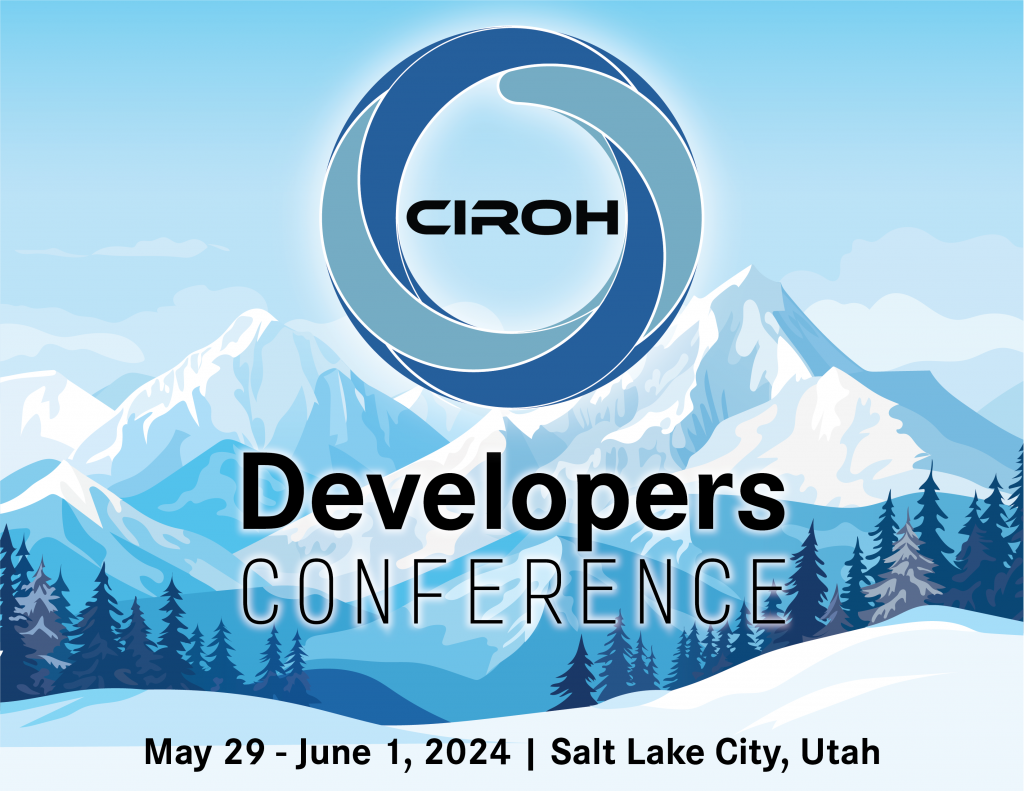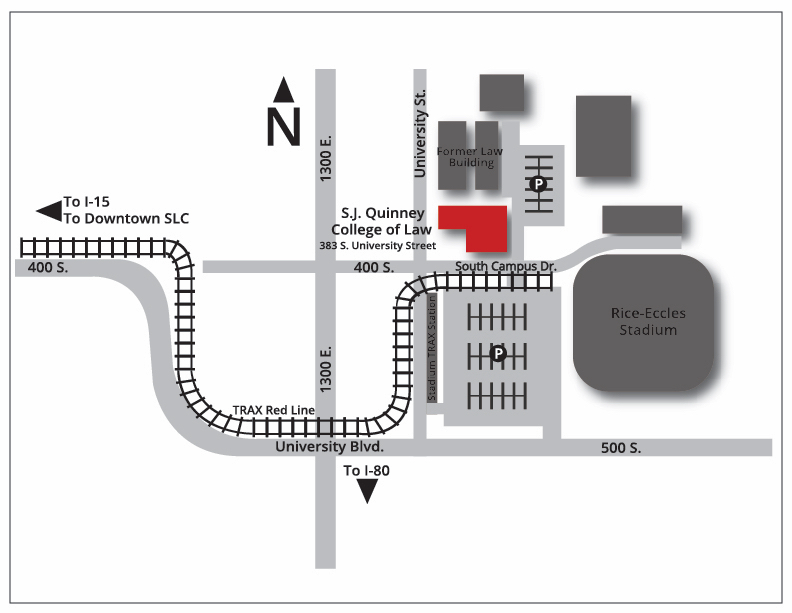
Introduction
CIROH is proud to host the 2nd Annual Developers Conference May 29 – June 1, 2024, at the University of Utah in Salt Lake City. The conference aims to develop a community of practice around CIROH’s research and development activities. The conference will be in-person only.
Who should attend?
The conference will focus on a wide range of topics relating to hydrological forecasting, particularly of extreme events – in line with CIROH’s current research and development emphasis. These include hydrological modeling (NextGen), flood inundation mapping, hydroinformatics, social science, and community engagement. The conference will offer participants an opportunity to engage with the CIROH community and its federal partners, learn about recent research and development activities, and get hands-on training on emerging models, tools, and services.
Agenda
The conference will feature a daily mix of keynote presentations, training workshops, poster sessions, and networking events.
Career-Building and Educational Field Activity

CIROH will be holding a transdisciplinary career-building and educational field activity at Atwater Study Plot near the top of Little Cottonwood Canyon in the Wasatch Mountains. Atwater is one of the longest running snow study plots in the Western US, and it now operates as a well instrumented snow energy and mass balance research site that is co-located with a traditional NRCS Snow Telemetry (SNOTEL) site. The motivation for this field activity is to connect CIROH researchers and educate them on snow observations and the role of snow hydrology for water resources in the Western US. The trip will be free of charge for all conference attendees and include the transportation of the participants from Salt Lake City to Alta, UT or other nearby locations depending on conditions. The activity will be outside and require appropriate clothing and footwear for hiking. It is likely that the short hike (10 min) to the site will be snow free at the end of May, but we will update participants about conditions as the activity approaches.
Keynote Presentations
Training Tracks
Workshops are organized as tracks that aim to provide a structured learning and training opportunity focusing on a specific topic. This year the tracks are:
- NextGen: The NextGen track is structured to provide comprehensive knowledge to participants from start to finish about NextGen, covering core concepts, tools, and experimental aspects. Day 1 focuses on core concepts and begins with an introductory session on NextGen and NextGen In A Box (NGIAB), followed by workshops on specific topics. Participants will engage in sessions led by experts covering NGIAB with Docker, hfsubset, forcing data and data access, realization files, and running NGIAB with custom input data. Day 2 transitions into tool-focused sessions, with workshops on data stream and forcing processors and NGIAB with Singularity, emphasizing its use in high-performance computing. Day 3 delves into experimental aspects, featuring sessions on evaluation tools led by TEEHR and argo workflow in the cloud.
- Flood Inundation Mapping (FIM): The track will provide well-rounded training on FIM, focusing on the operational OWP HAND-FIM framework as well as other FIM models and supporting tools. The workshop lineup and schedule are designed to follow the FIM application and development schema: compilation, evaluation, development, and application. Workshops will include an introduction session, software setup, OWP HAND-FIM and remote sensing application, evaluation against benchmark datasets, dissemination, and tool development.
- Hydrological Applications of Machine Learning (ML): The ML track will provide an overview of the theory behind various ML methods currently used within select CIROH projects and apply the methods to different modeling objectives. The workshop lineup will begin with an overview of the ML methods and hands on sessions for developing a ML pipeline. The hands-on workshop sessions will exemplify ML methods using current CIROH modeling projects seeking to advance the application of ML in operational hydrology, such as streamflow modeling, bias correction, snow modeling, and forcing data preparation. CIROH will provide the CIROH Cloud workspace to ensure environmental stability, workshop leads will provide the material on GitHub, and tentatively cover LSTM, Physics Informed ML, CNN, XGBoost, and MLP modeling algorithms. Track attendees can expect to leave with greater knowledge of data processing, ML models and their respective applications, training and evaluation procedures, result visualization, and a stronger foundation to apply the workflows to their unique hydrological modeling objectives.
- Hydroinformatics: This track will provide participants with knowledge of evolving CIROH informatics infrastructure. Workshops being planned include Data Science, HydroShare, HydroFabric and Tethys. Data science will cover applications of general statistical methods and data-driven modeling in CIROH. A HydroShare workshop will provide information on using HydroShare for collaboration and data and model sharing in CIROH, including links between HydroShare and CIROH computing. The Hydrofabric workshop will provide updates to the Hydrofabric that represents the geospatial infrastructure underpinning NextGen. The Tethys workshop will cover the development, use and deployment of Tethys apps for CIROH.
- Cross-cutting: This track includes cross-cutting workshops proposed and organized by the CIROH community and which do not align with only one of the other tracks. Workshops in this track include: using HydroLearn to support collaboration in developing, adapting and adopting educational material across universities teaching hydrology and water resources engineering applicable to operational hydrology; CIROH cloud infrastructure and AWS use case to overview the use of CIROH cloud and in premise infrastructure; Data Workflows 101 on the acquisition, manipulation and visualization of input data required for models; Working with National Water Model data in Amazon Sagemaker; Getting your model ready for NextGen with BMI; Introduction to GitHub; and others still being developed.
Poster and Lightning Talk Presentations
Important Dates
February 8: Registration and abstract submission opens
March 8: Training Tracks signup opens
March 8: Notification of acceptance
March 31: Nomination deadline for the Student Developer Award
April 15: Notifications about the Student Developer Award
May 28: Pre-conference networking activities (Salt Lake City, UT)
May 29 – June 1: CIROH Developers Conference (Salt Lake City, UT)
Dates subject to change. Please check back often to be sure of when deadlines are.
Registration
We reached the conference capacity. For special consideration email Meredith Marsh.
Registration fees:
Participants from CIROH Member and Partner entities: Free
Full: $200
Students: $100
Student Developer Award
Applications close March 31, 2024
The CIROH Annual Student Developer Award will honor a submission from a student who has demonstrated an outstanding contribution to CIROH’s research endeavors. The top submission will be invited to provide a keynote presentation at the conference and will receive travel support. Submission is restricted to students from the CIROH Consortium Members and Partners institutions.
To apply, send the following material to bssa-ciroh@ua.edu by March 31, 2023:
- A short description of your contribution to CIROH research [1 page];
- [Optional] A digital copy of one of your relevant thesis/dissertation chapter, research paper, or supporting documents [please do not submit your entire thesis!];
- [If relevant] A link to a public repository of your code or dataset with an open-source license, and technical documentation (optional);
- A letter of endorsement from the advisor – Please instruct them to email it directly to bssa-ciroh@ua.edu. It must be received no later than March 31, 2023.
Venue
The CIROH Training and Developer’s Conference will be held at the SJ Quinney College of Law Conference Center at the University of Utah.
Driving Directions and Address
S.J. Quinney College of Law – Level 6
383 South University Street
Salt Lake City, UT 84112
The College of Law is located on the northeast corner of 400 South and University Street (1400 East).
From the airport: As you leave the airport, keep to the left and take the I-80 E ramp to City Center/Ogden/Provo. Keep left at the fork, follow signs for I-80 E and merge onto I-80 E. Continue on I-80 for 5.5 miles to E 600 S/Martin Luther King Jr Blvd exit. Continue straight onto E 600 S/Martin Luther King Jr Blvd for .8 mile. Turn left onto S 1100 E. Continue for .3 mile, then turn right onto 400 S. Continue for .4 mile, turn left into the College of Law Parking Lot. Free parking is available in the College of Law parking lot, in any “A” or “U” parking stall (no permit is needed). Then enter the east entrance of the College of Law building and continue to the elevators to level 6.
From downtown: Drive east on South Temple Street to 1300 East Street. Turn right (south) and continue on 1300 East to 400 South. Turn left (east) on 400 South and then go through the traffic light and take the first left after the light into the College of Law Parking Lot. Free parking is available in the College of Law Parking lot, in any “A” or “U” parking stall (no permit is needed). Then enter the east entrance of the College of Law building and continue to the elevators to level 6.
Parking: Available for free just outside (east) of the building. If the lot is full, paid parking is available across the street at the stadium parking lot.
Public Transportation:
- TRAX (commuter train) “University” red line to the Stadium stop and walk a half block north. http://www.rideuta.com/
- For other public transit options use UTA’s Trip Planner.
- The law school is on the Red Route for the University’s free campus shuttles (College of Law stop). Live Tracker information is available at http://www.uofubus.com/
Campus Map: For more detailed information about the University of Utah campus, look at this University of Utah Campus Map.

For information about parking, driving and public transportation visit https://sjquinney.utah.edu/visit-our-campus/ and https://www.law.utah.edu/library/about-the-library/directions/
Lodging
There are many lodging options in Salt Lake City. If you plan to use public transportation you may want to consider booking a hotel in proximity to the TRAX (commuter train) “University” red line.
Organizing Committee
Dr. Sagy Cohen – University of Alabama
Dr. McKenzie Skiles– University of Utah
Mr. Sam Contorno– NOAA, OWP
Dr. David Tarboton– Utah State University
Dr. James Halgren – University of Alabama
Dr. Arpita Patel – University of Alabama
Dr. Ryan Johnson – University of Alabama
Ms. Lanna Nations – University of Alabama
Ms. Meredith Hope Marsh– University of Alabama
